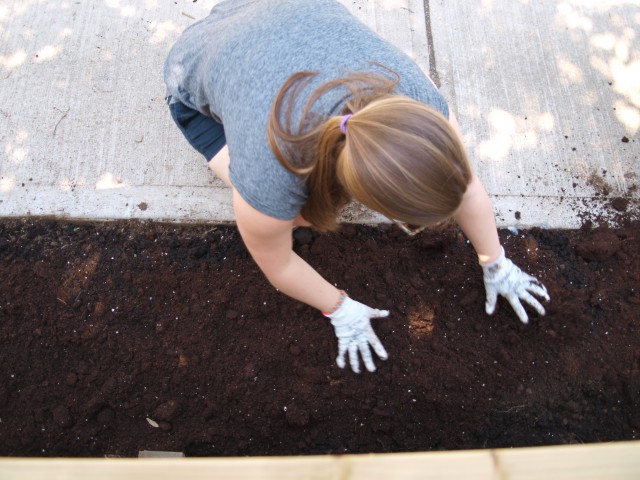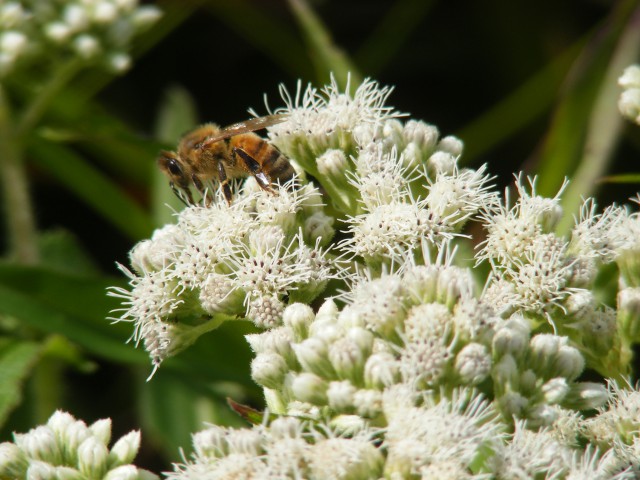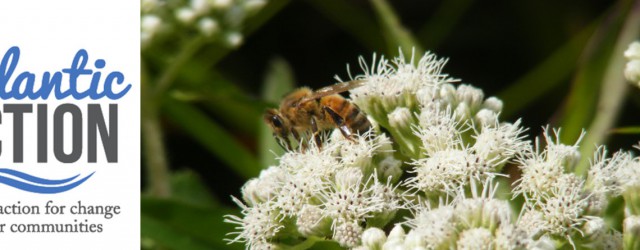This blog is the second in a series about our pollinator garden at Conserver House. You can find our first blog here.
With the completion of our new ramp and stairs thanks to Peter Cote, we began the preparation and planting of the Conservation Council of New Brunswick’s urban pollinator garden. The garden is being designed to create awareness around the importance of pollinator species. Our goal for this garden is to educate people on the importance of pollinators, and discover ways we can restore the populations of these important species! The plants we collected for our garden came from a local nursery, and David Smith’s Save A Native Plant Nursery in Fredericton.

We first began to prepare the present flower bed by loosening up the soil and adding fertilizer. To create space for the plants that needed shade, we created a new bed next to the ramp that was shaded by a maple tree. After careful consideration and with Nadine’s guidance, we chose a spot for each plant based on its tolerance to sunlight and aesthetics. After planting, we gave them all lots of water and placed mulch around them to help keep weeds away and to keep the plants cool and moist.

Our pollinator garden will attract many different animals like bees, hummingbirds, butterflies, moths, beetles, flies and even ants! Each pollinator likes different coloured flowers and different flower shapes. Bees like brightly coloured flowers, while beetles and flies prefer duller coloured plants like purple, white or green. Butterflies like narrow tubular flowers with a space for them to land, and bats prefer bowl-shaped flowers that are closed during the day.
When a pollinator lands on a plant, they move pollen from one flower to another, fertilizing the plant and allowing it to continue to grow. Pollinators play a fundamental role in maintaining species diversity within ecosystems around the world. Up to ¾ of the foods we eat require pollinators to reproduce! Thats a lot of food!

One of the plants we have in our garden is Canadian wild ginger. This native plant’s flowers lay close to the ground attracting pollinating flies and ants! When flies emerge from the ground after a long winter they look for their favorite food: animal remains. Flies confuse the scent of the flower for their favorite meal, collecting pollen and transferring it to other flowers along their way. This process pollinates wild ginger! Red trillium flowers also have the same putrid smell which attract flies.
Ants also help with the production of wild ginger. The seeds of wild ginger have an elaisome, a fleshy-like structure that is rich in lipids and protein. The ants bring the elasiome into the anthill to feed on. Luckily, the seeds remain intact and easily germinate in the moist and warm underground tunnels of an anthill. Bloodroot and celandine poppy are two other plants in our garden that also have elasiomes.
One plant favored by hummingbirds in our garden is garden columbine. This bell-shaped flower is available in various colours and because of its shape hummingbirds prefer it. We also have several plants to support butterflies such as veronica, new england aster and false solomon’s seal.
Bees pollinate the widest variety of plants in our garden. Plants included in this list are false solomon’s seal, echinacea, goldenrod, may-apple, chives and blue-flag iris. Bee’s hairy bodies collect pollen and transfer it from flower to flower. Bees in particular are irreplaceable pollinators and their disappearance could affect whole ecosystems. In recent years the honeybee population has taken a large hit, due to a number of factors including the growing popularity of a new group of pesticides called neonicotinoids.

Neonicotinoids are a group of synthetic pesticides that are chemically similar to nicotine. They can be applied as a coating to seeds, through spraying, by direct injection, or by adding the pesticide to irrigation water. Before 1990, the pesticides used to be applied directly onto the plant. Now they are spread throughout the plant, making all parts harmful to the insects feeding on them. This is not good for pollinators!
Bees and other pollinators can be exposed to neonicotinoids in a number of different ways, including contaminated pollen and nectar, direct spraying, residue contact, particles released during the planting of treated seeds, contaminated nesting areas and water. We made sure that none of our plants had been treated with any pesticides that might harm the pollinators that stop by!
So what exactly is happening to the bees here in New Brunswick? In 2013, New Brunswick had the second highest rate of wintering losses of honeybee colonies in Canada, at 26.3%. Since then, there have been a number of community responses from within New Brunswick regarding the decline in honeybee population. One beekeeper in St. Andrews, James Whitehead, is sharing his knowledge with other people in hopes of encouraging more urban beekeeping within the province. He says that even small scale beekeepers can make a difference to the bee population, and urban beehives can help protect the animals and cut down on pesticide-related bee deaths.

There are also groups within Fredericton and Moncton that currently have rooftop hives. One exists at the Crowne Plaza hotel in downtown Fredericton, which pollinates about a two-mile radius within the City of Fredericton. The honey produced from this hive is used at the hotel’s restaurant. The Delta Beausejour in Moncton also has hives set up that help pollinate their rooftop garden and surrounding areas within the city.
Now you may be thinking, what can I do to help? There are several things you can do in your own backyard to encourage pollinators:
- Planting a diversity of plants will help support a variety of different pollinators. Flowers of different colour, fragrance and season of bloom or plants of different heights will attract different pollinator species.
- Planting native species. Native plant species will provide shelter for pollinators and animals and will prevent invasive species, which can be harmful to wildlife and people.
- Build bee boxes to encourage solitary, non aggressive bees to nest on your property.
- If you are feeling more adventurous you can also get involved in backyard beekeeping.
- Leave some areas of soil uncovered to provide ground nesting insects easy access to underground tunnels.
- A clean, reliable source of water is essential to pollinators. Ensure water sources have a shallow or sloping side so the pollinators can easily approach the water without drowning.
- Avoid the use of pesticides on your lawn and gardens.
- Provide bird and bat boxes as a resting area for larger pollinators.
We hope that our pollinator garden here at Conserver House will attract many different pollinators and help educate everyone about the importance of these little creatures and the big role they play on our planet.

